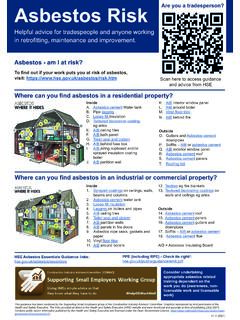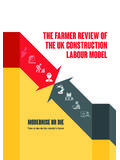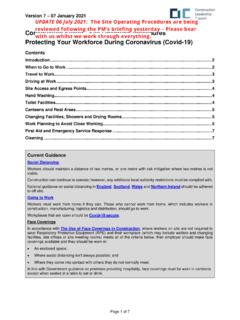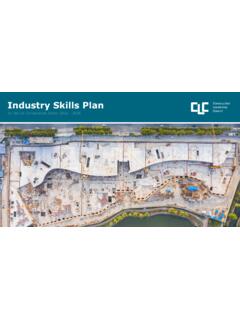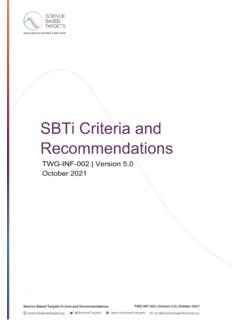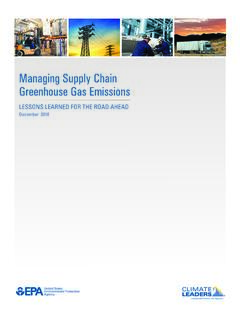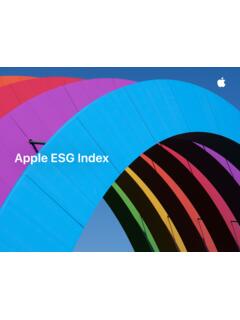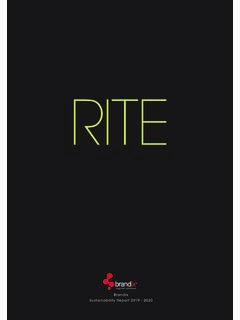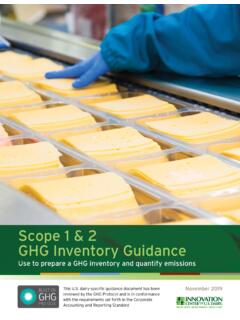Transcription of Guidance Document for PAS 2080
1 Guidance Documentfor PAS 2080 The world s first specification for managing whole life carbon in infrastructure100%50%80%20%2 Guidance Document for PAS 20803 Guidance Document for PAS 2080 Foreword PAS 2080 has the power to transform the benefits that the UK gains from its infrastructure assets. If all parties involved across the value chain work collaboratively and towards a common goal to reduce carbon, the following outcomes can be achieved: A reduction in the costs of delivering and maintaining our infrastructure driving more efficient ways of working and helping us to have an even greater impact on society and the communities that we serve. Effective carbon management an important contribution to tackling climate change and leaving a positive legacy for future generations. Delivering more sustainable solutions at lower cost enhancing the reputation of the industry, generating pride for those who work in it and attracting new people and skills to strengthen our capabilities.
2 A platform for innovation to thrive leading to more vibrant and rewarding Infrastructure Carbon Review recognized the opportunity. PAS 2080 helps us all turn this into reality. Thomas Faulkner, Executive Vice President, Skanska UK, Green Construction Board and Infrastructure Working GroupThe UK s Green Construction Board (GCB) and Department for Business, Innovation and Skills (BIS) formed a team from Mott MacDonald and Arup to write a new Publicly Available Specification (PAS) to show how carbon in infrastructure can be managed more rationally and Guidance Document has been developed by the same technical authorship team as for PAS 2080, namely Maria Manidaki, Priyesh Depala and Terry Ellis from Mott MacDonald, and Kristian Steele and Daniel Roe from Arup. Peer review support was provided by The Carbon Introduction1 Responsibilities of value chain members for implementing PAS 2080 Identification of the interdependent stakeholders who will take the lead on promoting, implementing and managing PAS How to implement the Carbon management Process Practical Guidance for implementing the requirements of PAS 2080 following the timeline of the infrastructure delivery work stages.
3 A number of case studies are included to support the The key components underpinning the requirements of PAS 2080 This section has been structured around the different elements of the PAS 2080 Carbon management Process. A number of examples/case studies are included to support the Quantification Worked Example58134464 AppendicesAppendix 1 Example data sources, quality applicability and contentAppendix 2 Carbon Emissions ReportsAppendix 3 Worked example supporting information717475with the generous support of the following organisations:4 Guidance Document for PAS 2080 List of Case StudiesCase Study A1 Strategy (demonstrating leadership, governance)Case Study A2 Development of BaselinesCase Study A3 i Quantification of BaselinesCase Study A3 ii Quantification of BaselinesCase Study A4 Early engagement and collaboration between Costain and Tarmac driving sustainabilityCase Study A5 Early engagement with material suppliers, CEMEXCase Study A6 Reporting on HS2 Case Study A7 Reporting Carbon Emissions QuantificationCase Study A8 M5 Junction 27 28 (Willand) Resurfacing Scheme (2014), SkanskaCase Study A9 Optimising performance and delivering reductionsCase Study B1 Target SettingCase Study B2 How National Grid integrates carbon management throughout investmentsCase Study B3 i Rail Safety and Standards Board (RSSB).
4 Rail Carbon ToolCase Study B3 ii Carbon Measurement tools, The Crossrail Scope 1, 2 & 3 predictor toolCase Study B4 Continual Improvement: London South Area Highway MaintenanceCase Study B5 HS2 Environmental Statement1822242529303334364046555960626 30 PAS 2080 shows a more systematic way for managing whole life carbon in infrastructure delivery. By joining up the value chain , a new culture of challenge and innovation is encouraged to help drive down carbon and cost. Making use of this Guidance Document for PAS 2080 will accelerate the understanding and use of the The industry has been calling for a clear and consistent approach to delivering low carbon infrastructure for the 21st century. PAS 2080 provides just that using a structured carbon management process which encourages full participation from all members of the value chain across the different work stages.
5 It is now up to us all to use it to make a quantum leap forward in carbon reduction. Adrian Johnson, Technical Director, MWH and Green Construction Board, Infrastructure Working Group6 Guidance Document for PAS 20807 Guidance Document for PAS 2080 This PAS includes requirements for all leaders and practitioner-level individuals in all value chain members (asset owners/managers, designers, constructors and product/material suppliers), to show the right leadership and to establish effective governance systems for reducing whole life carbon through the use of a carbon management process. The individual value chain requirements in the carbon management process are structured around the following components: Setting appropriate carbon reduction targets; Determining baselines against which to assess carbon reduction performance; Establishing metrics, Key Performance Indicators for credible carbon emissions quantification and reporting; Selecting carbon emissions quantification methodologies to include defining boundaries and cut-off rules; Reporting at appropriate stages in the infrastructure work stages to enable visibility of performance; and Continual improvement of carbon management and adopting PAS 2080, a more integrated value chain will form, communicating in a common language and working in a culture of genuine collaboration and innovation.
6 value chain members will be comfortable proactively challenging the status quo resulting in reduced carbon, reduced costs and increased more information on PAS 2080 please refer to The benefits of PAS 2080 Defining good carbon managementThe PAS will provide clarity to value chain organizations on what constitutes good carbon management and the key enablers to drive whole life carbon reduction. Businesses that can demonstrate they are PAS 2080: Asset Owners/Managers will have a good carbon management framework in their organization which fosters innovation, carbon and cost consistencyThe PAS will ensure carbon is consistently and transparently quantified at key points in infrastructure delivery, enabling carbon data to be shared transparently along the value competitiveness in the UKBusinesses that can demonstrate they are PAS 2080: Designers , PAS 2080:Constructors and PAS 2080.
7 Product/Material suppliers and hence able to deliver low carbon infrastructure will gain more work, while international clients who want to succeed in the UK infrastructure sector, will favour companies with a proven ability to cut cost by cutting AdvantageExperience of the carbon management principles and components of PAS 2080 with its positive message of improved carbon management and cost reduction will be viewed favourably when bidding for work overseas, especially in economies aiming to meet their international carbon reduction commitments, but unsure of the best 1: Content covered by PAS 2080 and Guidance DocumentDocument element PAS 2080 GuidanceSpecification for infrastructure carbon management Specification of value chain member responsibilities for carbon management in infrastructure delivery Practical Guidance on implementing a carbon management process by asset owners/managers and other value chain members when delivering assets and programmes of work Case studies and worked examples of carbon management process to PAS 2080 Where specific Guidance is given, relevant clauses in PAS 2080 are referred to within the text.
8 The style for this is as follows where the Guidance references Clause of PAS 2080, as an example: All value chain members shall implement an organizational carbon management process to help them meet their requirements when delivering assets and/or programmes of work (Clause ).Towards a common understanding and approachThe requirements of PAS 2080 will help establish a common understanding and approach for managing whole life carbon among infrastructure sectors (defined as water, energy, transport, communications and waste) and value chain Guidance Document has been developed to support practitioners with practical Guidance to support the implementation of the PAS through selected examples and case studies and insight on the underpinning components of the PAS 2080 carbon management this Guidance Document the word carbon is used as shorthand for all greenhouse gas (GHG) emissions in the same way that it is used within PAS of this Guidance DocumentTable 1 below clarifies the roles of this Guidance Document , highlighting how it should be used to support the effective use of PAS Target Setting2.
9 Baselines3. Quantification4. Continual Improvement5. Reporting6. Monitoring9 Guidance Document for PAS 20801 Responsibilities of value chain members for implementing PAS 2080 PAS 2080 will liberate dedicated professionals throughout the supply chain to do the right thing together. Tim Chapman, Leader Infrastructure London Group, Arup and member of Green Construction BoardInfrastructure is delivered, operated and maintained by a wide range of value chain member organizations. PAS 2080 is targeted at practitioner-level individuals in these organizations who are responsible for different aspects of infrastructure delivery and carbon management . The value chain members for whom PAS 2080 is relevant to include: Asset owners and managers; Designers; Constructors; and Product/Material suppliers. It is acknowledged that more than one value chain member may reside within a single organization.
10 For example, the asset owner/manager or constructor may also undertake some of the design work. It is therefore important to see the value chain as a set of roles to be fulfilled rather than specific organizations. Engagement profile of the value chain members and their practitionersThe Guidance shows where the key points of involvement for the value chain members will be. This includes which practitioner role in each value chain member is involved during infrastructure delivery delineated by the work stages for infrastructure delivery (PAS 2080 Figure 4).As required in the PAS, value chain members also need to implement the components of the Carbon management Process in their organizations (Clause ). Doing so will help them build relevant capability for delivering low carbon assets and programmes of work under the Carbon management Process of the asset owner/manager (as detailed in Section 2 of this Document ).

